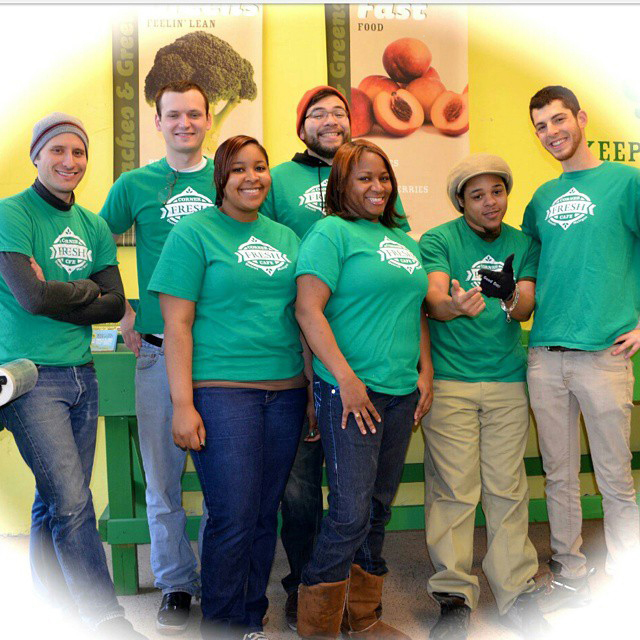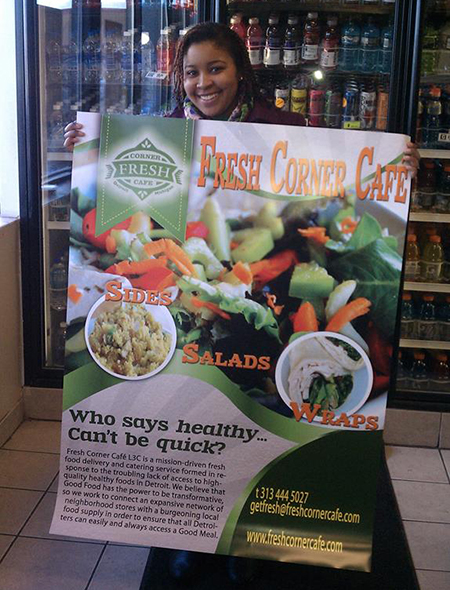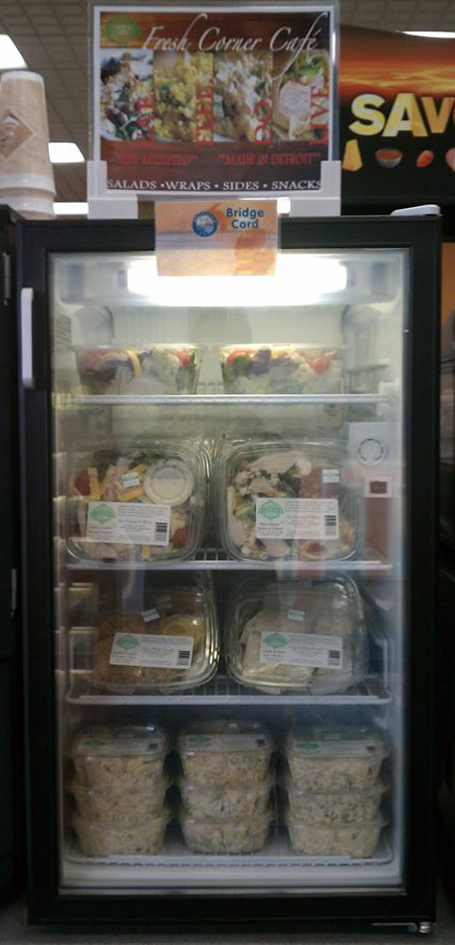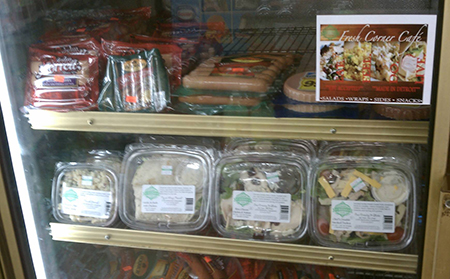
Detroit-based Fresh Corner Café focuses on making healthy food alternatives available to consumers in neighborhoods underserved by traditional food outlets like grocery stores. As these areas usually have a high concentration of gas stations and convenience stores, Fresh Corner Café utilizes them as a conduit to get nutritious meals and snacks into the hands of those that can’t access them any other way.
Freely acknowledging that his business model as originally conceived was rife with challenges, founder Noah Kimelman has refined the Corner Store Café concept from the beginning. To ensure viability, the company has come to embrace more traditional clients without losing sight of its core mission to ensure Detroiters always have good food to eat, regardless of where they live or what difficulty they may have in securing reliable transportation.
In the interview that follows, Kimelman talks about the challenges of running Fresh Corner Café, how it has evolved, and what he has learned from interacting with C-store owners and their customers who live in areas some call, “Food Deserts.”
For more information on Fresh Corner Café, please visit freshcornercafe.com.
SSCS: Walk us through how the idea for Fresh Corner Café originated and how you got the project off and running.

Val Waller, Fresh Corner Cafe co-owner, displays some of the attractive signage that helps a store market fresh food items.
Noam Kimelman: I attended undergraduate and graduate school at the University of Michigan in Ann Arbor. The concept first took shape during an interdisciplinary graduate class I attended called, “Social Venture Creation.” The purpose of the class was to try to create a revenue-generating, sustainable business model that was constructed around and addressed a pressing social concern.
In Detroit, many poorer neighborhoods don’t have enough access to fresh food, if they have any at all. Transportation is a big issue, too. It made sense that if you had no grocery stores, but you had convenience stores and gas stations on almost every corner, those outlets would be the best channel for getting fresh food to consumers that desired it. We believed if we could build a viable model, it would be something we could replicate quickly and scale up.
SSCS: What was it like when you initially went into stores to pitch the program?
NK: I was basically driving around town with sample food packages and talking to owners through bullet-proof glass. I’d show a salad or whatever else I was carrying that day, and a look of confusion would almost immediately come over the store owner’s face. I couldn’t get any traction at all when I pitched the mission part of the concept. They just wanted to know how they were going to make money off of the item that didn’t fit their store model. That was the reality; we had to deal with it.
So we began by guaranteeing the product, meaning we were willing to take back unsold, spoiled items. As terms these were obviously unfavorable to us, and wouldn’t be feasible in the long term, but we wanted to get the project off the ground so we did it at first.
As a result, we grew pretty quickly as a company, getting up to 35 stores within the first year, which is when we took a step back and began to re-evaluate our approach. The timing was right, not only because we had to stem our losses, but because we had begun to see how the Fresh Corner Café concept was playing out in the real world. We had enough information to make informed decisions about which accounts were working for us and why. We contracted down to the 15 stores whose performance indicated they were embracing the concept to a degree that it was working for them.
SSCS: How many stores do you have today?

This portable cooler is used not only in C-stores, but in work places, as well.
NK: Significantly more, but we don’t just work with corner stores anymore. We came to realize that even with top-performing corner stores, margins were thin. So we diversified our concept of catering. We deliver to cafes and bring food to workplaces. These revenue streams help pay for salaries and overhead. We’re also beginning to consider partnering with other outlets that can get good food into areas that need access to it, like a neighborhood community center.
SSCS: What characteristics are shared by gas stations and convenience stores that make the program work?
NK: The traits we noticed weren’t too surprising. The site had to be well lit. It had to be clean. It had to be established as a destination site for customers seeking out meals, prepared or otherwise. And the store owner had to be engaged by the idea.
SSCS: Did providing fresh meals change the dynamic between the store owner and their customer?
NK: Engaged store owners saw value in what we were offering, in part, because they understood it was a way to create better relationships with their customers. These owners also were open to in-store promotions, allowing us to come in and hold tasting events and demonstrations. If done right, those events add to the community by creating a neighborhood feel that surrounds the store. Forward thinking operators understood it was a market differentiator.
They also realized that if you carry fresh and healthy choices packaged attractively, you’ll be seen as having something no one else has. You’ll have fresh signage in your window, promoting your brand. But I’ll be the first to admit that the overwhelming number of corner stores in underserved areas are driven by immediate profit, and those stores just aren’t a good fit for us.
SSCS: Give us an idea of how a typical day at Fresh Corner Café plays out.
NK: Every day begins at 2:00 a.m., when the pair of food packers we use set about procuring and assembling the food items to our specifications. By 8:00 a.m., the items they pre-package and pre-label are ready to be picked up by our drivers, and our company spends the balance of the day taking care of distribution, account management, and marketing.
The delivery model we originally used has been tweaked. When we started we used a truck, but quickly realized a large vehicle wasn’t practical given the small size of our deliveries. So we switched to a fleet delivery model. Each of our drivers has a fixed route using their own vehicle and their own car insurance. It’s cost-effective and efficient. Each store gets its own bag of goods and the driver delivers it with a minimum of disruption to the store. Our analysis tells us that delivering to one store costs us $9.00, far, far less than it costs most food distributors. It’s not unusual to hear a company that distributes out of a large truck quote the cost of delivery at $45.00 per store, more when you take into account overhead.

Items can also reside on the shelf in the cooler next to more traditional items.
NK: Well, the real challenge is being committed to one of the most absurd business models there is: sell high-priced products with a short shelf life to low-income consumers with no stated demand for those products.
SSCS: Gee, when you put it that way…
NK: I can’t really underemphasize the challenges of being a provider of perishable items. We are obliged to stock a full display to maximize how appetizing our food looks, but we risk paying an almost immediate price, in terms of waste and spoilage, if we overstock. We’re still trying to find a balance between what looks good and what’s practical.
I should also mention that the date sensitivity of our items is a huge factor that influences our delivery schedule. We have to make sure the demand is there if we are going to cost justify multiple trips to a store within the same week.
SSCS: How did you go about pricing your items?
NK: Again, we had to see what worked in the market first, but lately we have made sure to price our items at five dollars or less. That seems to be a meaningful price point. We’ve learned to sift through the feedback and make sure we hear and react to the advice of customers that are seriously interested in, or even excited about, having fresh food at their corner store or gas station. Lack of access is the only thing keeping these consumers from eating healthy and that makes them our target consumer.
SSCS: At the end of the day, what’s most gratifying about being involved in Fresh Corner Café?
NK: Being able to provide healthy eating options for people who otherwise wouldn’t have them. I don’t claim to be a nutritionist. I’m not telling people how they should eat. But if someone wants to eat healthy, I’d like them to have the choice. I know how much better I feel when I eat healthy and how bad I feel when I don’t. Feeling physically poor after every meal is a horrible reality many face in Detroit. To be able to play a part in rectifying that problem is what makes it all worthwhile.






Leave A Comment